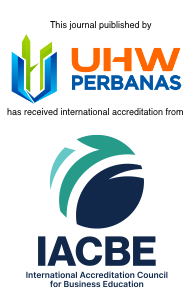The effect of covid-19 on bank proftability: Evidence of m-banking and e-banking in Indonesia
DOI:
https://doi.org/10.14414/tiar.v12i2.2889Keywords:
Mobile Banking, Covid-19 pandemic, Bank profitability.Abstract
Covid-19 affected the banks’ financial acitivities globally and, therefore, mobile banking can become solution for doing a distancing transaction. This study tries to observe if mobile transaction has significant effect of income in private and public bank in Indonesia. This study collects the data about bank profitability and the number of mobile banking users before and during Covid-19 pandemic from BCA and BNI in Indonesia. The data of mobile transaction is divided into three, mobile, internet, and SMS banking. The data of income divided into two, premium/net and operational income. The data is analyzed using linear regression method to observe if mobile transaction has effect toward income variables. The data is analyzed using SPSS. The result showed that before pandemic, those three mobile transaction have strong correlation toward the increasing number of net and total operational income in BNI. In BCA, mobile banking has a significant effect on net and total operational income. During pandemic, mobile transactions have negative correlation toward net income, while operational income has positive one for BNI, but negative for BCA. It can be concluded that  internet, mobile, and SMS banking have correlation toward net and total operational income.References
Abbas, A. E. (2017). Literature review of a cashless society in Indonesia: evaluating the progress. International Journal of Innovation, Management and Technology, 8(3), 193–196.
Abduh, M., & Azmi Omar, M. (2012). Islamic banking and economic growth: the Indonesian experience. International Journal of Islamic and Middle Eastern Finance and Management, 5(1), 35–47.
Arora, S., Bhaukhandi, K. D., & Mishra, P. K. (2020). Coronavirus lockdown helped the environment to bounce back. Science of the Total Environment, 140573.
Azali, K. (2016). Cashless in Indonesia: gelling mobile e-frictions? Journal of Southeast Asian Economies, 364–386.
Barata, A. (2019). Strengthening National Economic Growth And Equitable Income Through Sharia Digital Economy In Indonesia. Journal of Islamic Monetary Economics and Finance, 5(1), 145–168.
Bombarda, P. (2013). Intra-Firm and Arm’s-Length Trade: How Distance Matters? Firms in the International Economy: Firm Heterogeneity Meets International Business, 205.
Chelhi, K., El Hachloufi, M., Aboulethar, M., Eddaoui, A., & Marzak, A. (2017). Estimation of Murabaha Margin. Journal of Applied Finance and Banking, 7(5), 49.
Drigă, I., & Isac, C. (2014). E-banking services–features, challenges and benefits. Annals of the University of Petroşani. Economics, 14, 49–58.
Kumari, N., & Khanna, J. (2017). Cashless payment: A behaviourial change to economic growth. Qualitative and Quantitative Research Review, 2(2).
Lasmini, R. S., Budiarti, A. P., Tasman, A., & Susant, F. A. (2020). The Relationship Between E-Banking and Financial Performance of Go Public Bank in Indonesia. 4th Padang International Conference on Education, Economics, Business and Accounting (PICEEBA-2 2019), 903–909.
Lim, F.-W., Fakhrorazi, A., Ikhsan, R., Silitonga, K., Loke, W.-K., & Abdullah, N. (2020). The Role of Personal Innovativeness and Facilitating Conditions in Shaping the Attitudes of Mobile Internet Banking (MIB) Adoption among Generation Y in Malaysia.
Madavan, K., & Vethirajan, C. (2020). Customer Satisfaction on E-Banking Services of Public and Private Sector Banks in Puducherry Region-An Empirical Analysis. International Journal of Management (IJM), 11(6).
Obinna, O., Pfluegel, E., Clarke, C. A., & Tunnicliffe, M. J. (2017). A multi-channel steganographic protocol for secure SMS mobile banking. 2017 12th International Conference for Internet Technology and Secured Transactions (ICITST), 248–253.
Ojambo, M., & Yilmaz, N. (2020). Mobile Banking Activities and Technology Acceptance Models: A Case of Uganda. Tüketici ve Tüketim Araştırmaları Dergisi= Journal of Consumer and Consumption Research, 12(2), 403–454.
Patel, A., Praveen, D., Maharani, A., Oceandy, D., Pilard, Q., Kohli, M. P. S., Sujarwoto, S., & Tampubolon, G. (2019). Association of multifaceted mobile technology–enabled primary care intervention with cardiovascular disease risk management in rural Indonesia. JAMA Cardiology, 4(10), 978–986.
Prasetia, R., & Syah, T. Y. R. (2020). Impact of web design, assurance, customer service and brand image on intention to adopt internet banking and customer loyalty at Bank Central Asia (BCA). International Journal of Economics, Business and Accounting Research (IJEBAR), 4(01).
Purwanegara, M., Apriningsih, A., & Andika, F. (2014). Snapshot on Indonesia regulation in mobile internet banking users attitudes. Procedia-Social and Behavioral Sciences, 115, 147–155.
Purwanto, E., Deviny, J., & Mutahar, A. M. (2020). The Mediating Role of Trust in the Relationship Between Corporate Image, Security, Word of Mouth and Loyalty in M-Banking Using among the Millennial Generation in Indonesia. Management & Marketing, 15(2), 255–274.
Sariningsih, Y., Sp, E. J., & Dinihayati, E. (2019). The Group Dynamic of Business Group (e-Warong KUBE) towards a Cashless Society. Proceeding Interuniversity Forum for Strengthening Academic Competency, 1(1), 171.
Singh, S. K., Basuki, B., & Setiawan, R. (2021). The Effect of Non-Performing Loan on Profitability: Empirical Evidence from Nepalese Commercial Banks. The Journal of Asian Finance, Economics and Business, 8(4), 709–716.
Susilo, A. Z., Prabowo, M. I., Taman, A., Pustikaningsih, A., & Samlawi, A. (2019). A comparative study of factors affecting user acceptance of go-pay and OVo as a feature of Fintech application. Procedia Computer Science, 161, 876–884.
Tan, K. S., Chong, S. C., Loh, P. L., & Lin, B. (2010). An evaluation of e-banking and m-banking adoption factors and preference in Malaysia: a case study. International Journal of Mobile Communications, 8(5), 507–527.
Thusi, P., & Maduku, D. K. (2020). South African millennials’ acceptance and use of retail mobile banking apps: An integrated perspective. Computers in Human Behavior, 111, 106405.
Wardhana, A. K. (2020a). Information search trends about sharia: a comparation study between business-industry genre with book-literature genre. Journal of Halal Product and Research, 3(1), 35–42.
Wardhana, A. K. (2020b). Should be halal? is there any correlation between halal and vaccine? bibliography study in SCOPUS indexed academic paper. Journal of Halal Product and Research (JHPR), 3(2), 80–87.
Wardhana, A. K. (2021a). The Application of Waqf and Endowment Fund Based on the Principles in the Sharia Maqashid Pillar Society. Prosperity: Journal of Society and Empowerment, 1(2), 107–119.
Wardhana, A. K. (2021b). The Impact Of The Pro and Cons Policies In Jokowi Era’s On The Macro Economy Of Society. Jurnal Ekonomi Dan Bisnis Airlangga, 31(2), 124–136.
Widagdo, B., Jihadi, M., Bachitar, Y., Safitri, O. E., & Singh, S. K. (2020). Financial Ratio, Macro Economy, and Investment Risk on Sharia Stock Return. The Journal of Asian Finance, Economics, and Business, 7(12), 919–926.
Yang, M., Mamun, A. Al, Mohiuddin, M., Nawi, N. C., & Zainol, N. R. (2021). Cashless transactions: A study on intention and adoption of e-Wallets. Sustainability, 13(2), 831.
Zulkhibri, M., & Sukmana, R. (2017). Financing channels and monetary policy in a dual banking system: evidence from Islamic banks in Indonesia. Economic Notes: Review of Banking, Finance and Monetary Economics, 46(1), 117–143.
Downloads
Submitted
Published
How to Cite
Issue
Section
License
Copyright (c) 2022 The Indonesian Accounting Review

This work is licensed under a Creative Commons Attribution-NonCommercial 4.0 International License.


















